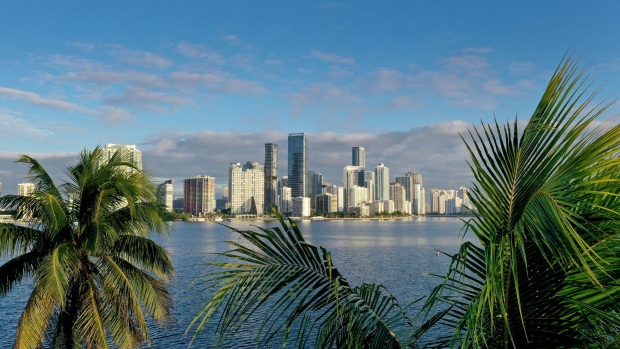May 7, 2024
NYC-Inspired Group Including Ken Griffin Seeks to Build Up Miami
, Bloomberg News

(Bloomberg) -- Andre Dua left New York for Miami in the summer of 2019 for family reasons.
In the hectic period that followed, he oversaw McKinsey & Co.’s outpost in the city as it grew to 400 employees from 100, part of a wave of finance, tech and business executives relocating for a world of sunshine and lower taxes.
Ana-Marie Codina Barlick has also lived through significant change in Miami. The Codinas first arrived in the city in the 1960s after her father, Armando, was sprung out of Cuba with thousands of other children via Operation Peter Pan. He then built a business empire in South Florida that his daughter, born in Miami, has expanded.
Now, Dua, Codina Barlick and 20 others are forming The Partnership for Miami, a group that brings establishment Miami together with its newest leaders including Ken Griffin, Dan Sundheim and Orlando Bravo. It’s an effort to influence the future of a city that’s changing dramatically, boosted by an influx of extraordinary wealth, but one that that faces significant infrastructure and equality issues.
“Miami has been on an incredible trajectory in the last five years,” said Dua, managing partner of McKinsey in Miami. “But past trajectory is no guarantee of future success and there’s a lot that needs to be done.”
The initiative is modeled on the Partnership for New York City, an influential group where the likes of David Rockefeller and Henry Kravis have made a mark by working with government to help chart comebacks from the Covid pandemic and the 9/11 terrorist attacks.
“We build relationships across sectors to rise up when there are issues no sector can deal with alone,” said Kathryn Wylde, Partnership for New York City’s CEO.
The Partnership for Miami will initially focus on the areas that have grown into the city’s biggest pain points: housing, transit and education.
Miami has experienced low unemployment and wage growth in recent years, but soaring real estate prices have led to the highest percentage of cost-burdened residents among large US cities, with Miami remaining one of the most unequal urban centers in America. Despite the influx of new residents, the Miami area’s population of 2.7 million has remained roughly stable as poorer residents left.
The population shift has aggravated transit issues and increased congestion rates. Public transportation ridership has declined roughly 25% over the past nine years in Miami and 92% of residents commute by car.
“We need a city that works for all,” said Codina Barlick, whose firm Codina Partners has a 250-acre (101.2 hectares) urban redevelopment project west of Miami. “We need Miami to be safe and business friendly, but we also have to make it attainable for everyone.”
On education, Miami ranks last among 23 other cities in STEM graduates. While pre-kindergarten enrollment is among the best in the US, only about half of Miami’s students from third to 12th grade performed at grade level in math or English language.
Read More: Palm Beach Elite Raise Money to Lure Vanderbilt to Florida
The Partnership’s initial member roster includes senior executives at some of the city’s main law firms, hospitals and sports teams, as well as from cruise lines and real estate. Traditional Miami dynasties, such as the Perez and the Mas families, are also represented. The apolitical group will be funded by members’ dues.
The Partnership for Miami isn’t the first time the city’s business leaders have joined forces for civic causes.
The Non-Group was created in the 1970s and acted mostly behind the scenes. Similar alliances were forged in times of crisis, such as when Hurricane Andrew devastated Miami in 1992. There’s also a Tampa-based non-profit, the Florida Council of 100, that congregates key business executives from across the state.
“People love to dunk on this place, but few American cities have had such a turnaround success story compared to where we were at the 1980s,” said Raul Moas, Partnership for Miami’s CEO. “I’ll take the challenges that we have today in Miami — transit, housing — any day over a declining population or a doom loop in real estate.”
--With assistance from Amanda Gordon and Michael Smith.
©2024 Bloomberg L.P.


